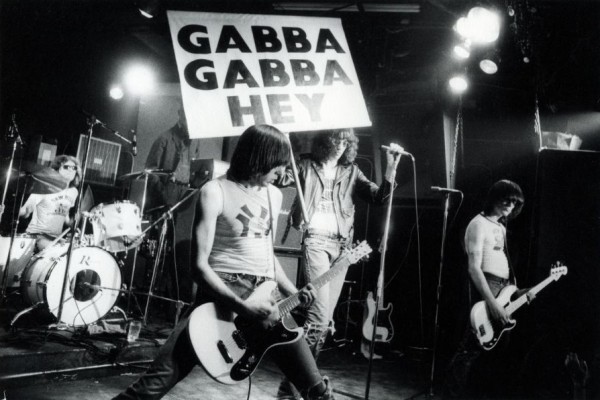
Today, we continue our recurring series, "Sonic Reducer." In the series, Punknews writers compress a band, genre, theme, or time period into a playlist that would fit on a single CD. Along with the playlist, you'll get either an overview of the topic, such as a band introduction, or a story about how the music in the playlist moved or changed the writer.
Today, Editor Greg Simpson takes a look at the golden age of CBGBs!
The Golden Age of CBGBs
There once was a bar and music venue at 315 Bowery on the Lower East Side of New York City that had a long and awkward name, albeit usually abbreviated: “Country, Bluegrass, Blues, & Other Music for Uplifting Gormandizers.” If you knew what every letter in CBGB OMFUG stood for already, 100 punx points for you. I’m positive our smart and well-read Punknewsers know a lot about the most famous punk club in history, with its modest stage, grimy floors and putrid bathrooms. By happenstance, the dive became the launching pad for scores of amazing bands in the mid-to-late 70s and remained one of the most iconic places for bands to play up to its closure in 2006. Some of those early bands rocketed to major label deals and stardom and the others, while they may not have achieved mainstream success, cemented their legacy within punk history. Perhaps I can fill in a story or fact that you didn’t know, or at the very least collect a bunch of the scene’s best songs in one place so you can have an enjoyable listening experience this afternoon. In this piece I’ll be focusing on the mutation of the blues spot into a punk hangout, and the first wave of bands that earned it the legendary reputation it fully deserved.

Photo by David Godlis
Before the first wave of punk began, CBGB owner Hilly Kristal was already expanding beyond the genres in the bar’s name into the realm of original rock acts, booking Squeeze (a local act, not the famous British band) for a residency; and, later, The Revelons, whose members included JD Daugherty, who would later form part of the Patti Smith group; and Fred Smith, the second bassist of Television.
Television was the first of the punk movement to play CBGBs, and what’s funny to me is that if this band had formed in 2017 rather than in the mid 70s they likely wouldn’t even be called a “punk band” with their heady, introspective and poetic lyrics, noodly guitar lines and lengthy songs. But that’s what was so great about that era in punk. No one knew what “punk” was exactly--the term was barely even being used--but all these groups were part of a scene and played together frequently. Most of them were friends, even though some of the bands would be called new wave (Talking Heads) or pop rock (Blondie) after the fact, but at the time nobody batted an eye or called out anyone for not being “punk enough.” That bullshit wasn’t a thing yet, and I wish I lived in this CBGBs era. How awesome would that be, to be part of a musical revolution and to witness their bands at the start?
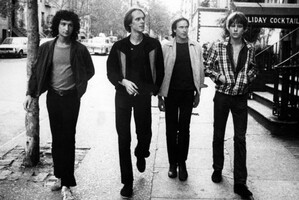
Photo by David Godlis
If it weren’t for Television, CBGBs likely would have been yet another unknown dive bar in one of the world’s largest cities. Tom Verlaine and Richard Lloyd, Television’s guitarists, were walking to the bus they would take to the band’s practice spot when they spotted the new club. Seemed as good a place as any to try and book their odd brand of rock and roll, and being on the then-seedy Bowery and located below a flophouse, they knew the band and their scuzzy, artsy friends could make a ruckus with few people caring, and most of the local residents were just as weird as them anyway. They introduced themselves to owner Hilly Kristal and when he told them the genres he wanted to feature at his club, they said, “Yeah we play a little blues, a little country…” and while the first is a stretch (rock is based in blues after all, but theirs doesn’t lean on it much at all), saying they played country was a complete and utter lie. Hilly was skeptical. But the band’s manager Terry Ork returned the next day and convinced Hilly that he’d make a lot of cash off the bar because “all our friends are alcoholics.” Ok, that part was true. Hilly booked them on his worst night, Sunday. The band walked away from the gig having made a dollar a piece.
Television didn’t release an album until early in 1977, and by then the infamous Richard Hell was out of the band (and had come and gone from The Heartbreakers, as well) and had been replaced by Fred Smith, but Marquee Moon is considered not only a crucial record in punk’s history but also an important album in rock music’s evolution. The 10-minute title track is the centerpiece of the record and every song is great (“Venus” is so, so good), but “See No Evil” kicks the record off with a perfect encapsulation of their sound. It’s smart but with a sneer, pounding you with power chords in the left channel, a catchy countermelody guitar line in the right, thumping beats and dancey rhythms, and ragged gang vocals in the background. Marquee Moon is a classic record, and Television remains one of my favorite bands of the scene.
 Photo by Judy Linn - 1969
Photo by Judy Linn - 1969
Already established as a poet, artist and musician for a couple years, Patti Smith links up with Tom Verlaine in CBGBs history because she pursued him and was involved in a love triangle with him and a guy named Allan Lanier (Smith later married Fred “Sonic” Smith of the important proto-punk band MC5--not the Fred Smith of Television--and didn’t even have to change her last name). She had made a name in the underground rock scene before CBGBs started up, playing other hip clubs like Max’s Kansas City, most famous to us punks for hosting the Velvet Underground and The New York Dolls on a regular basis. She was performing spoken poetry over wild guitar parts played by Lenny Kaye, whom Smith had instructed to “make the music sound like a car crash.” She eventually incorporated more singing into her style and more “songs” proper. She was the first of this CBGBs crew to release an album and get signed to a major label, putting out the front-to-back fantastic Horses on December 13th, 1975 on Arista. As with Television’s debut (but keep in mind Horses came first), the centerpiece is its longest song, “Land,” but also like Marquee Moon, the opening track acts as her mission statement, one shared by punk rockers worldwide in the coming years: to take rock and roll back to its roots. She does so by straight-up lifting the title and chorus to “Gloria” by Them, Van Morrison’s first band. She makes it her own with its attitude and the original verse sections, but it’s a shot across the bow to mid-70s wank-rock and prog acts by saying, “this is what rock and roll is supposed to be.” Plus, it starts the album with one of the greatest first lines of an album ever, and goddamn is it punk rock: ”Jesus died for somebody’s sins but not mine.”
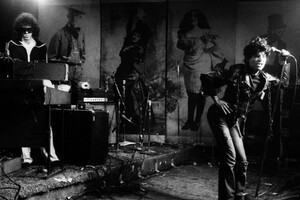
Photo by David Godlis
Alongside Patti Smith, another group known as a “CBGBs band” was actually around long before the club became the hippest, weirdest spot in town: Suicide. Despite having no guitars or real drums in the band, they were undisputedly punk. Maybe that made them more punk. Martin Rev’s pulsing primal drum machines and dark Farfisa organ tones through distortion pedals underneath Alan Vega’s (another 2016 musical casualty) creepy storytelling makes “Frankie Teardrop” one of the scariest and most dramatic songs to come out of the CBGBs scene. In the 80s, Springsteen said in an interview that “Frankie Teardrop” was ”one of the most amazing records I think I’ve ever heard” and it seems to have directly influenced “State Trooper” off of his album Nebraska, as a similar tale of murder over sparse, spooky musical backing. With that kind of praise, hopefully you’re convinced to spend the next 10 ½ minutes with this song.
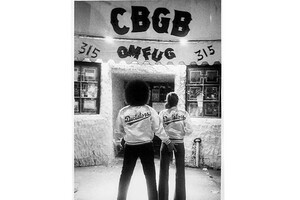
Legs McNeil was arguably the most famous scenester to call CBGB home, not famous for being in bands but for his DIY journalism with his magazine PUNK, and he is even (partially) attributed as coining the term or at least helping it to catch on. His favorite band and one of the main reasons he started the magazine was The Dictators. They were a ridiculous live band (especially mascot/frontman Handsome Dick Manitoba, who had a great sense of humor but also a knack for melody and capturing that “old-school” rock and roll sound). Also, if you’ve never read Please Kill Me, an oral history of the NYC punk scene in the 70s, told in a collection of interviews compiled by McNeil and Gillian McCain, get right on that. It’s probably my favorite book about rock music, with Our Band Could Be Your Life being its only close competition. A lot of the information contained in this feature can be attributed to that book. Here’s my favorite Dictators’ song, “I Live for (Cars & Girls)” from their 1975 debut Go Girl Crazy, and it captures that Beach Boys spirit but with some cheekiness and punk fervor.
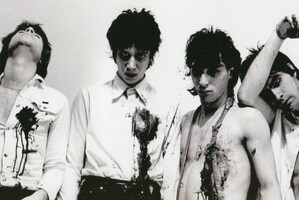 Photo by Roberta Bayley - 1974
Photo by Roberta Bayley - 1974
The Heartbreakers were Johnny Thunders and Jerry Nolan’s band after they quit The New York Dolls (in large part, because Malcolm McLaren had implemented a silly and misguided Communist visual shtick for their stage show) and Richard Hell had just quit Television. They hooked up and made some amazing music, fueled by heroin; in fact, hey wanted to name the band The Junkies but were talked out of it. Richard Hell must have been Hell to work with, because Johnny Thunders quit the band and Nolan followed when Hell was attempting to lead the group. Thunders had too big of an ego to let that happen. They essentially reformed without him, so Hell does not appear on their sole studio album, L.A.M.F. (Like A Mother Fucker), an album with amazing songs but pretty shoddy production--so shoddy that the band basically broke up over it. Here’s my two favorites from the album, “Born to Lose” and “One Track Mind.” Get it? Because all they thought about was heroin! “Chinese Rocks” appears for the first time on this album as well. Dee Dee and Hell wrote the song together but the Ramones didn’t want to sing about hard drugs (apparently by End of the Century they were up for breaking that rule) so Hell brought it to The Heartbreakers. They continued to play it after his dismissal from the band. You can find that song in addition to these two on the Spotify playlist at the bottom of this feature.
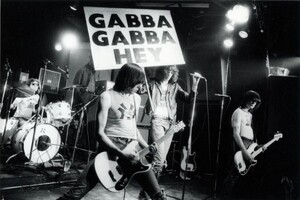
Photo by David Godlis
We all know the Ramones famously played their first gigs at the dive. I won’t spend much time here because I know after “Ramones Week” here at Punknews awhile back you are all Ramones experts! I watched the End of the Century: The Story of the Ramones documentary again recently and it’s funny to hear the locals (the woman who ran the door at the club; Legs McNeil; Danny Fields, who would become their manager; and Sire records founder Seymour and Linda Stein) talk about their first experiences seeing the Ramones. Most of them describe it as somewhat funny at first, as if it was so simple, so loud, so fast, that it had to be some sort of joke, and, if not that, performance art more than a legit band. But then they all fell in love with them. Here’s a few of my favorite early Ramones songs, the first being “Judy is a Punk,” the first song the Ramones ever wrote and the one that convinced Tommy (the most business-minded of the group) that the Ramones were gonna be something. “What are these lyrics?!” he thought. And you can’t go wrong with “53rd & 3rd,” Dee Dee’s song inspired by his real-life experiences as a male prostitute, scoring money for drugs.
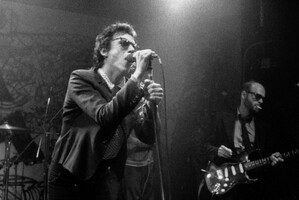
Photo by David Godlis
Richard Hell, already mentioned frequently in this piece, was a figure in the Bowery scene and played the CBGB stage dozens of times before ever committing to tape on an album, having quit (or been kicked out of, depending on who tells the story) Television and The Heartbreakers. He formed his own band and attached his name to it (you can’t be kicked out of a band with your name in it, right?), Richard Hell & The Voidoids. The drummer of the Voidoids was Marc Bell, a hard-hitting and tight player (and he later would become Marky Ramone, replacing Tommy in the Ramones). Hell reminisces about CBGB: ”Though I spent some of the most intense and even happiest times of my life there, it was nowhere joint - a dark, rundown, hard-luck drinkers’ bar.” He goes on to praise owner Hilly Kristal, saying ”He was like the one grown-up you liked when you were a kid - he just let you be yourself.” Hell was the quintessential CBGB regular.
The single Voidoids record is pretty great, and that shitbag Malcolm McLaren ripped off not only Hell’s personal fashion style of ripped clothing and safety pins and used it for the Sex Pistols, but he straight up lifted Hell’s “Blank Generation” sentiment and told the Pistols to write their own version and what we got was “Pretty Vacant.” Compare them below.

Most people think of Blondie as a pop group, blowing up with their 3rd album Parallel Lines’s “Heart of Glass,” their take on disco. It was pretty cool though, really, ‘cause what other disco song can you think of that has 5/4 measures thrown in? Try dancing to that! In their youth, Debbie Harry and co. got their start at CBGB alongside the Ramones and everyone else, and their first album will always be my favorite. In its own way, it fit the punk mission statement of taking rock and roll back to its roots. My favorite track, and favorite Blondie song ever, “X-Offender” (originally titled “Sex Offender’), nods to girl group and Phil Spector in many ways, from their own take on the Ronettes’ “Be My Baby” drum intro, to the castanets (a Spector secret weapon), to the “Leader of the Pack”-style spoken intro. All this while the lyrics tell the story of wanting a police officer to come on to her, calling herself (or the protagonist of a fictional tale?) a “sex offender” for wanting some kinky sex. P-u-n-k PUNK. Respect.
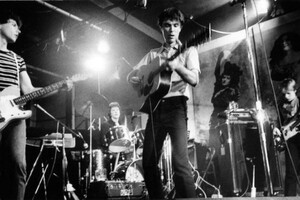
Photo by David Godlis
The Talking Heads were the art school nerds of the CBGB scene. David Byrne played with an acoustic guitar, how unpunk (read: awesome) is that? Their first show ever was at CBGB in June of 1975. Their amazing debut 77 was released in--you guessed it-- ‘77, and while “Psycho Killer” seems like an obvious choice, who cares? It defined their sound (funky, jaunty, raw) and lyrical style (dark, smart, and artsy [lyrics in French?]). It’s awesome to think that a song this cool could chart, but it did.
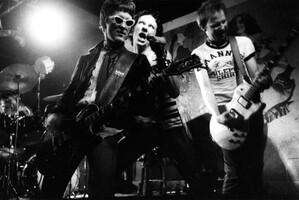
The Dead Boys from Cleveland, OH were the first out-of-town band to fully integrate into the early CGBG scene, relocating there and becoming regular performers. They were nuts and, looking back on it, one of the most “punk” of all the groups in the sense of the term nowadays: They were reckless on stage, bizarre, dressed weirdly, were super snotty (hence the title of their debut album Young, Loud and Snotty), and lived the lifestyle by getting into lots of trouble. The name of this recurring feature is a reference to their most famous song, so I’m required to play that one. More songs are in the Spotify playlist at the bottom. Here’s “Sonic Reducer,” the opening track from their debut.
Many more amazing bands got their starts at CBGB (The Misfits and Beastie Boys both played their first shows there) and many other amazing bands graced the stage early on (B-52s, The Runaways, The Cramps, hell even AC/DC played there in 1978), and all of the early UK punk bands were visiting by the end of the 70s (not just punk, but stuff like The Police, Elvis Costello, and more) but that sums up the best of the first wave of CBGB bands. It was such an amazing scene it’s hard to even comprehend these days: a family of friends and musicians making amazing music, inspired by each other but not a copycat amongst them. Without a doubt, the club known as CBGB was the hub for a turning point in American music and rock music as a whole, and this website would not even exist if it wasn’t for Hilly Kristal taking a chance, Television weaseling their way in, and this whole group of early bands paving the way for music to go back to its roots of simplicity, creativity and raw energy. Punk was born there. Respect.